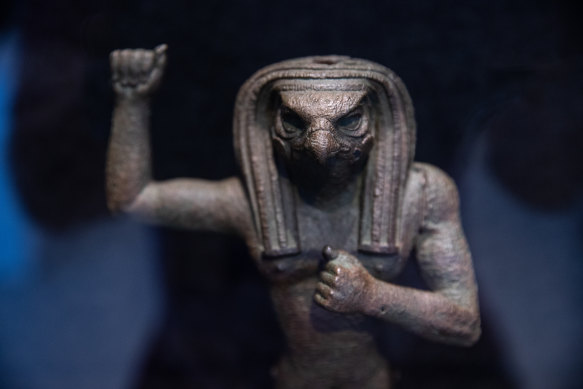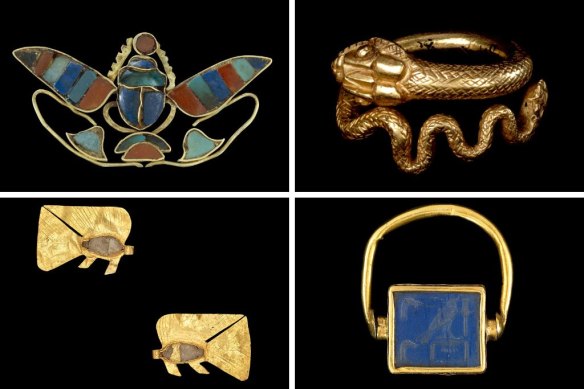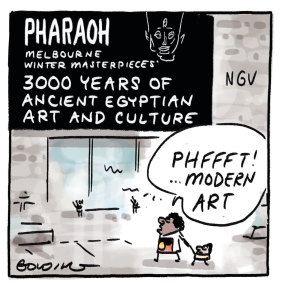
The scenography gives breathing space to artefacts that are breathtaking for their size and physical presence: a remarkably intact life-sized sculpture of Pharaoh Sety II, a phalanx of 10 lion-headed statues representing the goddess Sekhmet, an intricately decorated coffin base made for the afterlife of a temple doorkeeper. Wall projections offer glimpses of the sky in different aspects and undulating waters suggestive of the Nile, grounding the exhibition in a sense of place.

Detail of an exhibit of figures of a king and two gods in jubilation.Credit: Simon Schluter
There is one section entirely devoted to jewellery, which Vandenbeusch sees as “an exhibition within the exhibition”. Seldom displayed at the British Museum, these pieces reveal the level of craftsmanship and skill employed by Egyptian makers, as well as the role that jewellery and body adornment played in the lives of ancient Egyptians.
“This was an amazing opportunity for me to explore this part of the collection,” explains Vandenbeusch. “These pieces are very intimate, because people wore them and it meant something to them: it was about beautification, but it was also about symbolism and meaning. I’m quite attracted by those small pieces, which tell a different level of stories.”
That said, Vandenbeusch has not neglected the titular pharaohs; the exhibition opens with a space that introduces the god-kings and their world. “It evolves through six different kings and six different objects,” Vandenbeusch explains. “I wanted people to encounter those pharaohs without preconceived ideas.”
One such idea is that all the pharaohs were male. Here, Vandenbeusch has selected a range of objects related to the life of Hatshepsut, who came to power following the death of her husband, the pharaoh Thutmosis II.

Jewellery from the exhibition, clockwise from top left: Ornament of a winged scarab holding a sun-disc; ring in the shape of a snake; ring showing Thutmose III as a sphinx trampling over an enemy; and amulets in the shape of a fish.
Hatshepsut ruled as pharaoh for more than 20 years and her reign was marked by peace and prosperity.
Yet in the decades following her death, monuments bearing her image were defaced and her name was quite literally erased from historical accounts – such as a stone tablet, featured in the exhibition, from which her name has been chipped off in a way to remove her from the chronology of pharaonic succession.
“It tells so much about what it meant to be a king, but also a woman in ancient Egypt,” Vandenbeusch says.

Credit: Matt Golding
For Vandenbeusch, it’s this sort of piece that offers the most insight into the ancient civilisation. “When you start looking at those objects, you get to the people,” she says. “That’s what I love about ancient Egypt – it’s not about pharaohs, it’s about people. And I think that’s what’s fascinating.”
Pharaoh is on at NGV International from June 14 to October 6.
The Booklist is a weekly newsletter for book lovers from books editor Jason Steger. Get it every Friday.



























